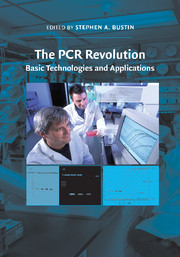Book contents
- Frontmatter
- Contents
- Contributors
- Foreword by Russell Higuchi
- Preface
- I BASIC TECHNOLOGIES
- II APPLICATIONS
- 10 Polymerase chain reaction–based methods for the detection of solid tumor cancer cells for clinical diagnostic and prognostic assays
- 11 Polymerase chain reaction and infectious diseases
- 12 Polymerase chain reaction and respiratory viruses
- 13 Polymerase chain reaction and severe acute respiratory syndrome
- 14 The MMR vaccine, measles virus, and autism – A cautionary tale
- 15 Noninvasive prenatal diagnosis using cell-free fetal nucleic acids in maternal plasma
- 16 Polymerase chain reaction–based analyses of nucleic acids from archival material
- 17 Microarrays and quantitative real-time reverse transcriptase–polymerase chain reaction
- 18 Polymerase chain reaction in the detection of genetic variation
- 19 Polymerase chain reaction: A blessing and a curse for ancient deoxyribonucleic acid research
- Index
- Plate section
- References
12 - Polymerase chain reaction and respiratory viruses
Published online by Cambridge University Press: 25 January 2011
- Frontmatter
- Contents
- Contributors
- Foreword by Russell Higuchi
- Preface
- I BASIC TECHNOLOGIES
- II APPLICATIONS
- 10 Polymerase chain reaction–based methods for the detection of solid tumor cancer cells for clinical diagnostic and prognostic assays
- 11 Polymerase chain reaction and infectious diseases
- 12 Polymerase chain reaction and respiratory viruses
- 13 Polymerase chain reaction and severe acute respiratory syndrome
- 14 The MMR vaccine, measles virus, and autism – A cautionary tale
- 15 Noninvasive prenatal diagnosis using cell-free fetal nucleic acids in maternal plasma
- 16 Polymerase chain reaction–based analyses of nucleic acids from archival material
- 17 Microarrays and quantitative real-time reverse transcriptase–polymerase chain reaction
- 18 Polymerase chain reaction in the detection of genetic variation
- 19 Polymerase chain reaction: A blessing and a curse for ancient deoxyribonucleic acid research
- Index
- Plate section
- References
Summary
A BRIEF INTRODUCTION TO THE FEATURES OF RESPIRATORY VIRUSES AND THE ROLE OF POLYMERASE CHAIN REACTION IN DETECTING THEM
The principal detection of a virus in respiratory secretions tends to bestow upon it the colloquial title of a “respiratory virus.” Human respiratory viruses are the most numerous and most highly diverse, organ-defined group of viruses that we currently know of; not surprising, considering their efficient method of transmission. They infect with greater frequency (infections per person per year) and with a broader coverage (annual number of infected people worldwide) than does any other infectious agent. To date, most acute respiratory tract infectious entities are known to be viruses, and most of these have a monopartite ribonucleic acid (RNA) genome. Viruses, being what they are, intimately associate with human cells and secretions, from which they must be discriminated. This can make them difficult to detect, let alone characterize. Most of the modern focus on respiratory virus detection is now drawn by molecular methods. At the forefront of these, both in research and routine diagnostic laboratories, is the polymerase chain reaction (PCR), a technique lauded for its ability to detect a target from among a far superior number of nontarget sequences.
Data from the reinvigorated arena of respiratory virus research are pushing many new and old infectious disease issues to the forefront of microbiology, none more so than the question of what is required of our experimental design to determine whether a virus detected from the respiratory tract is the cause of respiratory symptoms.
- Type
- Chapter
- Information
- The PCR RevolutionBasic Technologies and Applications, pp. 189 - 211Publisher: Cambridge University PressPrint publication year: 2009
References
- 1
- Cited by



